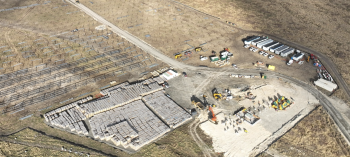Image Caption
Local Journalism Initiative Reporter
Windspeaker.com
The Nlaka’pamux Nation Tribal Council (NNTC) is part of an historic solar facility that is being constructed in British Columbia.
Details of the quA-ymn Solar project, which is being built just southwest of Kamloops, were announced on Nov. 4.
The project is a partnership between the six NNTC member communities and BluEarth Renewables, a leading power-producing company which has lengthy experience in renewable energy projects across North America.
The project is going ahead as it has secured a $35 million loan from the Canadian Infrastructure Bank (CIB).
The new project will feature a 15-megawatt solar facility, which will connect into BC Hydro’s energy grid. The power generated will be sufficient enough to generate more than 2,000 homes annually.
“This is not a project initiated by a non-Indigenous group,” said Matt Pasco, the chief of the NNTC. “It started as an Indigenous-led project.”
Pasco said NNTC officials first started discussing the concept of a solar project in 2010. But it wasn’t until 2016 that NNTC partnered with BluEarth Renewables.
“It took several years for us to be working and pushing on what project we wanted to be doing,” he said. “We looked at wind and water projects. But solar looked like a very viable option for us to contemplate.”
The quA-ymn Solar project is the first industrial grade solar project in British Columbia. Pasco explained other existing solar ventures in the province, are all projects of one megawatt or less and are for individual buildings or homes.
“This one is directly plugged into the grid,” he said.
Though details were only publicly shared on Nov. 4, Pasco said work on the project has been ongoing for the past couple of months.
“They’ll probably have to do some troubleshooting,” he said. “But we expect to be complete by mid-summer (of 2025).”
Despite being pleased the project will become a reality, Pasco said it is disappointing that it has taken this long for a major solar project to be built in the province.
“It’s nothing short of embarrassing it has taken this long,” he said.
Grant Arnold, the president and CEO of BluEarth Renewables, is pleased his company joined forces with the tribal council to work on this initiative.
“This is our first of many projects together,” he said. “We view this as a long-term relationship with significant growth potential and look forward to pursuing future opportunities with the NNTC.”
Though he was reluctant to provide any additional information, Pasco said the NTTC is currently exploring a total of five other solar and wind projects.
Arnold offered his thoughts on why the quA-ymn Solar project has been through a lengthy process.
“Generally speaking, development of wind and solar projects takes many years,” he said. “These are long-term assets that last more than 30 years, so there is a large amount of upfront regulatory work, engineering, and due diligence that goes into the development process.
This project is located in British Columbia, where the power market is controlled by BC Hydro, so that also impacts how projects are developed and brought online.”
Arnold added the solar facility is an important contribution to the B.C. grid.
“One of the interesting things about this project is that it is located on reclaimed land at the Teck Highland Valley Copper mine, which is a great example of how we can take land that is otherwise unusable and turn it into a positive benefit,” he said.
Arnold also said there are other benefits as well.
“The project will provide approximately 100 jobs at peak construction and full-time employment opportunities to support operations,” he said. “At the time of the time of commissioning, quA-ymn will be the largest solar facility in B.C. and the first to utilize bi-facial modules in the province.”
Ehren Cory, who is the CEO of the CIB, is also pleased to be involved. He believes this project will help towards economic reconciliation.
“Every infrastructure project which has an Indigenous ownership component helps to advance economic reconciliation,” he said, adding quA-ymn Solar demonstrates the NNTC’s resilience and provides it with the economic tools to build viable, sustainable renewable energy projects that generate economic and employment opportunities for their members.
Cory also said the solar project can lead to spinoff benefits.
“Revenues earned by the NNTC can be reinvested into the member communities in a variety of areas, including other clean power infrastructure and community redevelopment,” he said.

